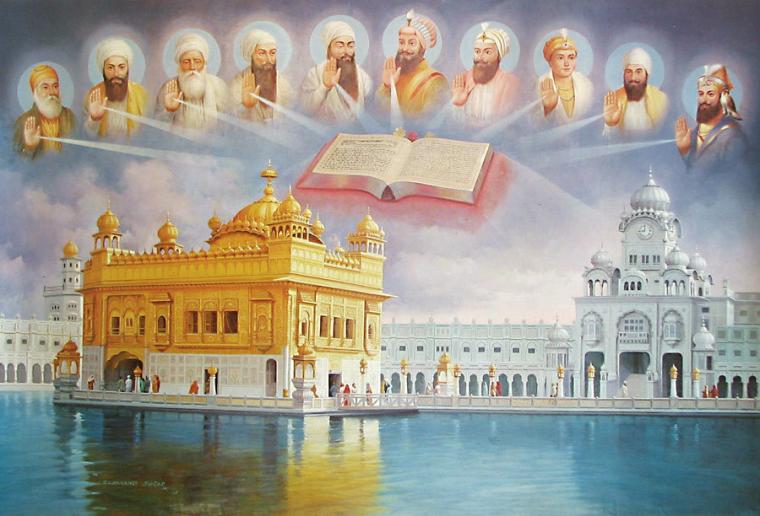The Epic Story of Ten Gurus Who Shaped a Nation Without a Throne: The Sikh faith, one of the youngest religions in the world, was shaped over more than two centuries by ten enlightened Gurus. Each Guru contributed uniquely to the spiritual, social, and political foundations of Sikhism. From the teachings of Guru Nanak Dev Ji to the militarized spiritual awakening under Guru Gobind Singh Ji, this divine lineage guided a community from humble beginnings to a bold, united force.
Here is the journey of those ten Gurus, whose leadership transformed a spiritual path into a dynamic way of life — grounded in service, equality, justice, and devotion.
1. Guru Nanak Dev Ji (1469–1539)
The Founder of Sikhism
Born in Nankana Sahib (now in Pakistan), Guru Nanak Dev Ji introduced a revolutionary idea — that all humans are equal and God is one. Rejecting caste, religious divisions, and ritualistic practices, he spread his message of love and unity across Asia and the Middle East through extensive travels known as Udasis. His compositions, filled with spiritual depth and social reform, laid the core of Sikh philosophy.
2. Guru Angad Dev Ji (1504–1552)
Preserver of Teachings
Chosen as the successor by Guru Nanak, Guru Angad Dev Ji standardized the Gurmukhi script, which later became the scriptural base for Sikh writings. He promoted physical activity, especially wrestling, to strengthen both mind and body, and expanded the community’s reach by sending trained missionaries.
3. Guru Amar Das Ji (1479–1574)
Champion of Social Equality
Guru Amar Das Ji institutionalized Langar (free community kitchens) as a way to promote equality, ensuring everyone — regardless of caste or background — shared meals side by side. He challenged social evils like sati (widow burning) and supported the empowerment of women in religious roles. His efforts laid the groundwork for a community built on dignity and shared responsibility.
4. Guru Ram Das Ji (1534–1581)
City Builder and Visionary
Guru Ram Das Ji, the fourth Guru, established the town that would become Amritsar, the spiritual capital of Sikhism. Notably, Emperor Akbar gifted land to his wife, Bibi Bhani, in appreciation of the Guru’s spiritual work. On this land, Guru Ram Das Ji initiated the construction of a sacred tank, which later came to be known as Amrit Sarovar, around which the Golden Temple would eventually be built.
Guru Ram Das Ji, the fourth Guru of the Sikhs, was not only a spiritual guide but also a visionary city planner. During his leadership, he began developing a sacred site that would eventually become the spiritual center of Sikhism. In the 1570s, he selected land near a natural pond to build a town for the growing Sikh community.
According to Sikh tradition, Mughal Emperor Akbar, impressed by the Guru’s humility and message of equality, granted land to Bibi Bhani, the Guru’s devout wife and daughter of Guru Amar Das Ji. This land became the foundation for the Guru’s plan to build a spiritual haven open to all.
At the heart of the site was a sacred tank, which Guru Ram Das Ji began excavating with the help of his followers. It was initially called “Amrit Sarovar”, meaning “Pool of Nectar”, symbolizing a place of spiritual rebirth and purification.
Over time, the settlement around the holy pool took on the name of the water body itself — Amrit Sar, which later evolved linguistically and in common speech into Amritsar. The pool was later expanded and completed under the guidance of Guru Arjan Dev Ji, who also oversaw the construction of the Harmandir Sahib (Golden Temple) at its center.
Amritsar, today, is not only the most sacred city for Sikhs but a symbol of inclusion, community, and resilience — all rooted in the vision planted by Guru Ram Das Ji and the nectarous pool, Amrit Sarovar, from which it takes its name.
5. Guru Arjan Dev Ji (1563–1606)
Compiler of Sikh Scripture and First Martyr
Guru Arjan Dev Ji compiled the Adi Granth, the first official version of Sikh scripture, including hymns of earlier Gurus and respected saints from other traditions. He completed the Harmandir Sahib (Golden Temple), making it open to people of all backgrounds. His rising influence concerned Mughal Emperor Jahangir, who ordered his arrest. Guru Arjan Ji was subjected to extreme torture and ultimately executed in 1606 — becoming the first martyr of the Sikh faith and marking a shift from peaceful resistance to defensive readiness.
6. Guru Hargobind Ji (1595–1644)
Spiritual Warrior and Defender of Faith
Following his father’s martyrdom, Guru Hargobind Ji introduced the concept of Miri-Piri, signifying the balance of spiritual guidance and worldly power. He wore two swords to represent this dual responsibility and established the Akal Takht, a throne of spiritual justice, opposite the Golden Temple. He prepared the Sikh community to defend itself while continuing spiritual teachings.
7. Guru Har Rai Ji (1630–1661)
Guardian of Nature and Compassion
Guru Har Rai Ji continued to uphold the martial traditions while leading a peaceful life. He was known for his love of nature and herbal medicine and maintained a strong spiritual foundation within the growing Sikh community. His generosity extended to all, including providing medicine to Mughal prince Dara Shikoh, despite political risks.
8. Guru Har Krishan Ji (1656–1664)
Child Saint and Servant of the Sick
At just five years old, Guru Har Krishan Ji became the youngest Sikh Guru. Despite his youth, he showed great maturity and compassion. During a smallpox epidemic in Delhi, he tended to the sick and offered comfort. He passed away at age eight, leaving behind a legacy of selfless service. His last words, “Baba Bakale,” pointed to the next Guru.
9. Guru Tegh Bahadur Ji (1621–1675)
Protector of Religious Freedom
Guru Tegh Bahadur Ji was a staunch defender of the right to religious choice. When Aurangzeb forced Hindus to convert to Islam, Guru Tegh Bahadur stood in opposition. Arrested and taken to Delhi, he was beheaded in public for refusing to give up his faith. His sacrifice was not only for Sikhs, but for the freedom of all people to practice their own religion, earning him the title “Shield of India” (Hind-di-Chadar).
10. Guru Gobind Singh Ji (1666–1708)
Creator of the Khalsa and Last Human Guru
Guru Gobind Singh Ji gave the Sikh identity its final shape. On 13 April 1699, at Anandpur Sahib, he called a large gathering and initiated five Sikhs — the Panj Pyare (Five Beloved Ones) — into the Khalsa, a community of initiated warriors dedicated to defending justice and righteousness. The Khalsa were bound by discipline, spiritual devotion, and distinct symbols, known as the Five Ks: Kesh, Kanga, Kara, Kirpan, and Kachera.
Before his death in 1708, Guru Gobind Singh Ji declared that the Guru Granth Sahib would be the eternal Guru of the Sikhs, ending the line of human Gurus. He left behind not only a scripture and a brotherhood but a bold new vision of resistance, equality, and spiritual sovereignty.
In Summary: From Enlightenment to Empowerment
The legacy of the Ten Sikh Gurus is a journey that began with spiritual revolution and culminated in the creation of a fearless, justice-seeking community. They stood for equality, truth, service, and the right to live and worship freely. The foundation laid by Guru Nanak was built upon with devotion, intellect, courage, and ultimately, sacrifice.
Their teachings, enshrined forever in the Guru Granth Sahib, continue to illuminate the path of millions — reminding us that divinity lies not in separation, but in unity, humility, and action.





You are my breathing in, I possess few web logs and often run out from brand :). “Actions lie louder than words.” by Carolyn Wells.